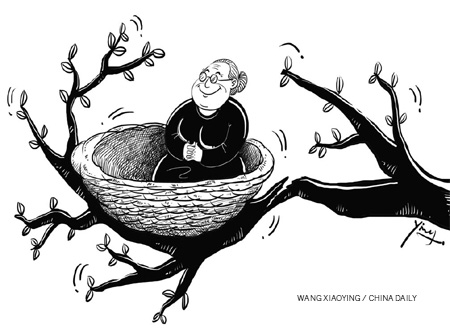Opinion
Economics of aging population
By Andrew Mason (China Daily)
Updated: 2011-06-01 10:42
 |
Large Medium Small |

The National Bureau of Statistics has released the results of the sixth national census. China remains the most populous country in the world with more than 1.3 billion people and continues to experience population growth at a moderate pace of about 0.5 percent a year.
China's fertility rate is so low, however, that population decline and rapid population aging are imminent. These demographic changes will have profound implications for China's economy, the role of the public sector and families concerned about their prosperity and economic security.
To understand the enormity of the demographic changes facing China one need look no further than children's population trend. In 1976, the population under the age of 15 years reached a historic high of nearly 360 million according to United Nations estimates. The 2010 census shows that the country now has only about 222 million children (0-14 years old).
During the last 35 years the number of children has declined by about 138 million, and over the next 35 years the UN projects a further drop of more than 80 million. China is experiencing a "baby bust", which is unprecedented for its magnitude and the speed with which it has occurred.
| ||||
The decline in the number of children has freed up resources that have been put to good use by the public and private sectors both. Some of these resources have been used to improve standards of living and reduce poverty, some have been saved leading to increased capital accumulation and some have been used to increase per child spending on education and healthcare.
Generally speaking, China has used part of its demographic dividend to raise current living standards and part to invest in the future. China's current age structure is now the most favorable in its history. Its population is heavily concentrated in the ages where people are most productive and have the highest earnings. Relatively few people are young or old when production is low and consumption is high. The age structure is highly favorable for public finances, too. Taxes are paid predominantly by working-age adults, while benefits go predominantly to the young as well as the old.
But China has reached a turning point. Demographic conditions are becoming unfavorable as the "baby bust" generation comes of age - entering and progressing through the working ages.
Currently, the "baby bust" is pushing down the number of people in their early 20s. In another 10 years, the number of people in the 20s and early 30s will be in decline. With each passing year, a larger share of the labor force, too, will be in decline.
The aging population is growing and will continue to grow very rapidly. The speed of aging will depend primarily on whether the fertility rate recovers from its currently low level or declines further as has been the case in South Korea and Japan. If China's total fertility rate begins to recover from its current level of about 1.5 to 1.6 births per woman, about 34 percent of its population will be 60 years or older in 2050. But if the total fertility rate declines to lower levels, about 39 percent of its population will be 60 years or older by then.
During the last few years a group of Chinese scholars, led by Li Ling, a professor at Peking University, has been collaborating with researchers at the East-West Center and the University of California, Berkeley, to assess whether countries around the world are prepared for the aging of their populations.
How does China compare? First, aging is beginning in China when its per capita income is much lower than in rich countries. And because China is a relatively new market-based economy, many of its institutions and systems that will be increasingly important are not fully developed. Of particular note are China's rural health and pension systems.
Second, China has one of the highest saving rates in the world but the accumulated wealth may not fund the retirement needs of the elderly, who currently rely little on personal assets to fund their old-age needs.
Third, financial support for the elderly from their adult children is modest in China. Taking other East Asian countries as an indicator, the economic importance of the family system is likely to decline further as China becomes wealthier.
Hence, providing for the economic security and prosperity of its aging population will be an enormous challenge for China, particularly if the fertility rate continues to decline.
The author is a professor of economics at the University of Hawaii and senior fellow at the East-West Center.
| 分享按鈕 |



